Pan-searing is a culinary technique that brings sizzling excitement to the kitchen, infusing dishes with tantalizing flavors and mouthwatering aromas.
It involves cooking food, typically meats or seafood, in a hot pan with a splash of oil or butter, creating a crispy, caramelized exterior while sealing in succulent juices.
This method unlocks a symphony of tastes and textures, making each bite a culinary adventure that delights the senses.
Whether you’re a seasoned chef or an adventurous home cook, mastering the art of pan-searing adds a touch of gourmet flair to your repertoire, elevating ordinary meals to extraordinary dining experiences.
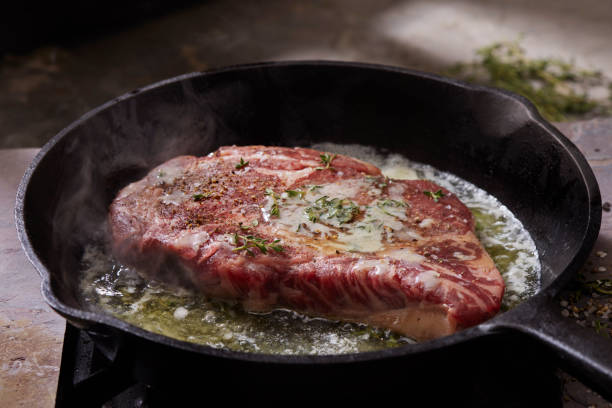
What Is Pan Seared
Pan searing is a cooking technique that involves quickly cooking food items, typically meat or fish, in a hot pan with a small amount of oil or fat.
This method creates a flavorful crust on the outside of the food while keeping the inside tender and juicy. Pan-seared dishes are often described as having a caramelized exterior, which adds depth and richness to the overall flavor profile.
Chefs and home cooks alike use this technique to achieve a beautifully browned surface and a succulent texture in dishes like steaks, chicken breasts, or salmon fillets.
The process usually begins by heating the pan until it’s hot enough to sear the food, then adding the oil or fat and placing the food item in the pan to cook quickly on each side until done to the desired level of doneness.
How Do You Pan Sear?
Pan-searing is a popular cooking technique that involves quickly searing food in a hot pan to create a flavorful, caramelized exterior while retaining the juices and tenderness inside. Here’s how you can pan-sear like a pro:
Step 1: Preparations
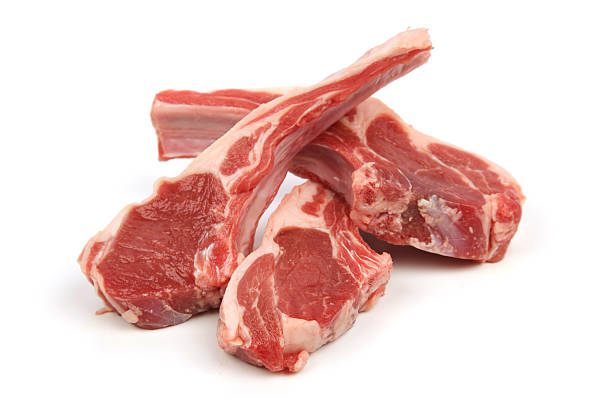
Preparations are crucial when it comes to pan-searing to ensure a successful and delicious outcome. Begin by selecting the right pan for the job, preferably a heavy-bottomed pan like a cast-iron skillet that can withstand high heat without warping.
It’s essential to preheat the pan over medium-high to high heat for a few minutes until it reaches the desired temperature, which is hot but not smoking.
This initial preparation sets the stage for proper browning and caramelization of the food, creating that irresistible flavor and texture that pan-searing is known for.
Step 2: Heating The Pan
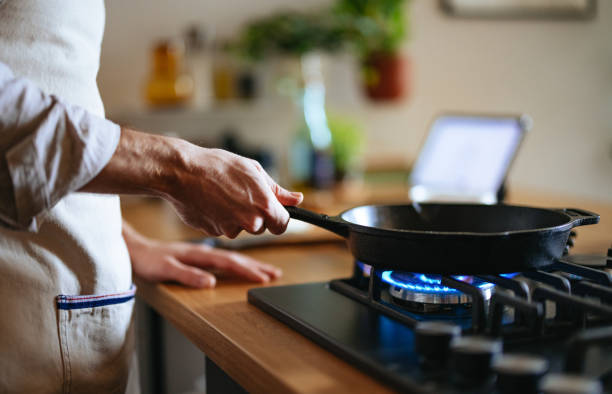
Heating the pan is a essential step in the pan-searing process. Once you’ve selected the appropriate pan, such as a heavy-bottomed skillet, it’s time to heat it to the right temperature.
Preheat the pan over medium-high to high heat for a few minutes until it’s hot but not smoking. This ensures that the pan is evenly heated, allowing for proper browning and caramelization of the food when it’s added.
A hot pan also helps to create a sear without steaming the food, resulting in a flavorful crust and juicy interior. Taking the time to heat the pan correctly sets the stage for a successful pan-searing experience.
Step 3: Adding The Oil
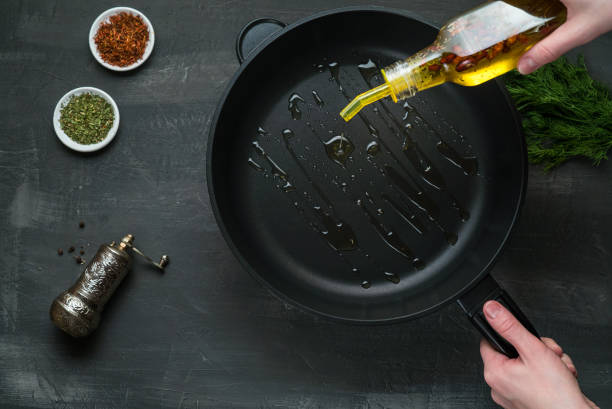
Adding the oil is a necessary step in the pan-searing process that contributes to achieving the desired texture and flavor of the food.
Once the pan is properly heated, it’s time to add a high-heat oil like canola, vegetable, or grapeseed oil. Swirl the oil in the pan to coat the bottom evenly, creating a thin, even layer that helps in searing and prevents sticking.
The oil also plays a vital role in transferring heat to the food, promoting even cooking and caramelization. It’s important not to add too much oil, as excess oil can lead to smoking and a greasy texture.
By adding the right amount of oil and ensuring it’s evenly distributed, you set the stage for a successful pan-searing process.
Step 4: Adding The Meat
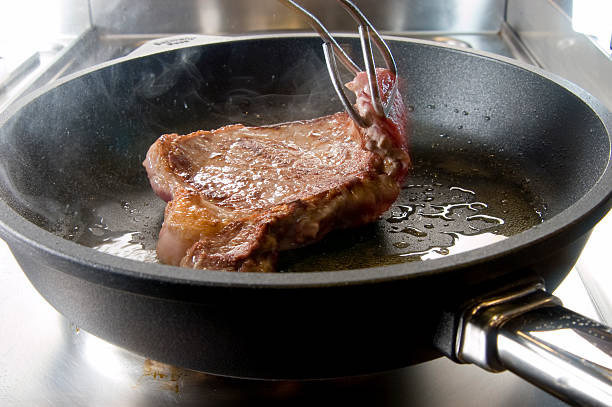
Adding the meat is a fundamental step in the pan-searing process that requires attention to detail for optimal results. Once the pan is properly heated and the oil has been added, carefully place the seasoned meat into the hot pan.
It’s essential not to overcrowd the pan, as this can prevent proper browning and caramelization. Leave some space between pieces of meat to allow for even cooking and the development of a flavorful crust.
Avoid moving the meat around too much once it’s in the pan, as this can disrupt the searing process. Let the meat sear without disturbance for a few minutes on one side until it develops a golden brown crust, then flip it to sear the other side.
This step is crucial for creating a deliciously seared exterior while keeping the inside tender and juicy.
Step 5: Baste
Basting is an optional but highly effective step in the pan-searing process, especially when cooking thicker cuts of meat or poultry. To baste, tilt the pan slightly and use a spoon to scoop up the hot oil and juices from the pan, then drizzle them over the meat as it cooks.
This process helps to keep the meat moist and adds extra flavor by infusing it with the pan drippings. Basting also contributes to the development of a beautiful glaze on the exterior of the meat, enhancing its visual appeal and overall taste.
However, it’s important to baste sparingly to avoid cooling down the pan or causing flare-ups. Mastering the art of basting can take your pan-seared dishes to the next level, resulting in succulent, flavorful meat that’s sure to impress.
Types of Foods Suitable for Pan Searing
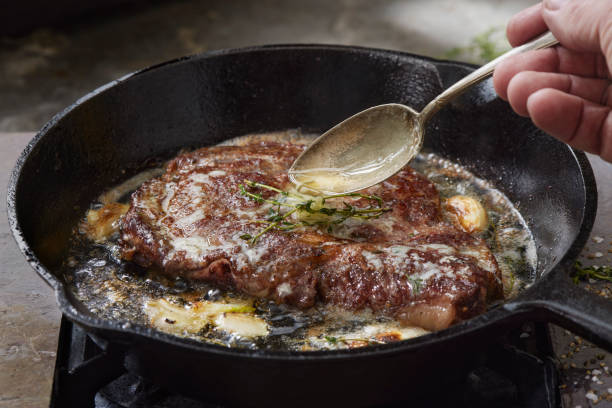
Meats
Pan-searing is ideal for a wide range of meats, including beef, pork, chicken, and lamb. Thick cuts like steaks and chops are particularly well-suited for this cooking method as it allows for a flavorful crust while keeping the interior tender and juicy.
Ground meats, such as burgers and meatballs, can also benefit from pan-searing to develop a caramelized exterior.
Seafood
Seafood such as fish fillets, scallops, shrimp, and even lobster tails can be beautifully pan-seared. The quick cooking time and high heat help to achieve a delicate sear on the outside while preserving the delicate texture and moisture of the seafood inside. Pan-searing seafood is a popular method for creating restaurant-quality dishes at home.
Vegetables
While pan-searing is often associated with meats and seafood, many vegetables also shine when cooked using this technique.
Vegetables like mushrooms, asparagus, Brussels sprouts, and bell peppers caramelize beautifully in a hot pan, developing a deliciously crispy exterior while retaining their natural flavors and nutrients.
Pan-searing vegetables can elevate their taste and texture, making them a delicious side dish or addition to salads and pasta dishes.
Pan-Searing Recipes
Pan-Seared Steak
Pan-searing steak is a classic method to achieve a beautifully caramelized crust while keeping the inside tender and juicy. It’s essential to preheat the pan and use a high-heat oil to promote browning.
The key to a perfectly pan-seared steak is to sear it on each side without moving it too much, allowing for a flavorful crust to develop. Resting the steak after cooking is crucial to allow the juices to redistribute and ensure a succulent bite.
Pan-Seared Chicken Breasts
Pan-searing chicken breasts is a quick and delicious way to cook this versatile protein. Start by seasoning the chicken breasts and preheating the pan. Pan-searing chicken breasts allows for even cooking and a golden brown exterior.
It’s important to cook the chicken until it reaches the proper internal temperature to ensure it’s cooked through but still moist and tender. Adding herbs, garlic, or a simple pan sauce can enhance the flavor of pan-seared chicken breasts.
Pan-Seared Salmon with Lemon Garlic Butter Sauce
Pan-seared salmon is a flavorful and nutritious dish that’s perfect for a quick and healthy meal. Season the salmon fillets and preheat the pan before adding them. Pan-searing salmon creates a crispy skin while keeping the flesh moist and flaky.
A lemon garlic butter sauce adds brightness and richness to the dish, complementing the natural flavors of the salmon. It’s important to cook salmon just until it’s cooked through but still slightly translucent in the center for the best texture.
These pan-searing techniques can be adapted to different cuts of meat or fish and paired with various seasonings and sauces to create a wide range of delicious dishes. Adjust cooking times and temperatures based on the thickness of the food and your desired level of doneness.
Tips and Techniques for Perfect Pan Seared Results
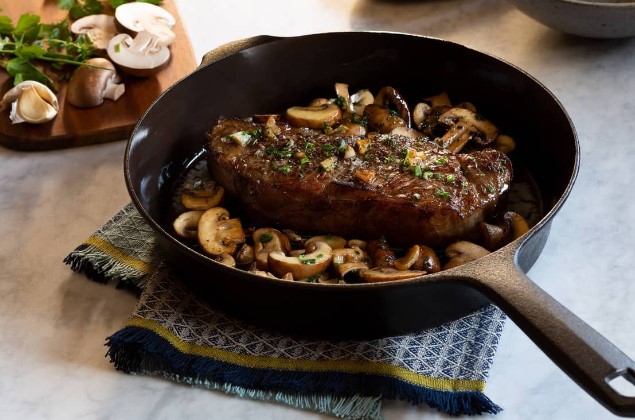
Choosing the Right Pan
- Select a heavy-bottomed pan, such as a cast-iron skillet or stainless steel pan, that can withstand high heat without warping. A good pan with even heat distribution ensures consistent and thorough cooking of your food.
Using the Correct Oil or Fat
- Opt for oils with high smoke points like canola, vegetable, or grapeseed oil for pan-searing. Avoid using butter or olive oil at high temperatures, as they can burn easily and affect the flavor of your dish.
Searing at the Appropriate Temperature
- Preheat your pan over medium-high to high heat before adding the food. The pan should be hot but not smoking. This ensures a proper sear and caramelization without burning the exterior of your food.
Avoiding Overcrowding the Pan
- Give your food enough space in the pan to ensure even cooking and browning. Overcrowding can lead to steaming instead of searing, resulting in a less crispy texture and unevenly cooked food.
Allowing the Food to Rest After Searing
- After removing the food from the pan, let it rest on a plate or cutting board for a few minutes. This allows the juices to redistribute, resulting in a juicier and more flavorful final dish.
By following these tips and techniques, you can achieve perfect pan-seared results every time, with beautifully caramelized exteriors and tender, juicy interiors in your favorite meats, seafood, and vegetables.
Comparison with Other Cooking Methods
Pan-searing is a versatile cooking method that offers unique advantages compared to other cooking techniques. Here’s a comparison with some common cooking methods:
Pan-Searing vs. Grilling
- Pan-searing is done on a stovetop using a pan, while grilling is typically done outdoors on a grill.
- Pan-searing allows for more control over the cooking temperature, making it suitable for delicate foods like fish.
- Grilling imparts a smoky flavor to food due to direct exposure to flames or charcoal, while pan-searing creates a flavorful crust through high heat and oil.
Pan-Searing vs. Roasting
- Pan-searing involves cooking food quickly in a hot pan with oil, resulting in a caramelized exterior and juicy interior.
- Roasting involves cooking food in an oven at a lower temperature for a longer time, allowing for even cooking and caramelization.
- Pan-searing is ideal for thinner cuts of meat or seafood, while roasting is better suited for larger cuts or whole pieces.
Pan-Searing vs. Frying
- Pan-searing and frying both involve cooking food in oil, but pan-searing uses less oil and is done at a higher heat.
- Pan-searing creates a crispy exterior without fully submerging the food in oil, while frying submerges the food and can result in a heavier, greasier texture.
- Pan-searing is often preferred for healthier cooking as it requires less oil and retains more nutrients.
Pan-Searing vs. Baking
- Pan-searing is a faster cooking method that creates a caramelized crust on food, while baking involves cooking food slowly in an oven for even heat distribution.
- Pan-searing is suitable for foods that benefit from a crispy exterior, like steaks and vegetables, while baking is ideal for dishes that require longer cooking times, such as casseroles and baked goods.
Overall, pan-searing offers a balance of speed, flavor development, and control over cooking temperatures, making it a popular choice for achieving deliciously seared dishes with minimal effort.
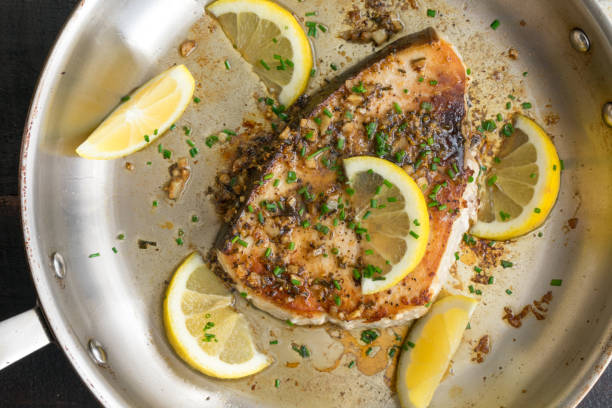
Frequently Asked Questions (FAQs) – What Is Pan Seared
Q: What is pan-seared cooking, and why is it so popular?
A: Pan-seared cooking involves quickly searing food, typically meat or fish, in a hot pan to create a flavorful crust while sealing in juices. It’s popular because it results in tender, juicy, and delicious dishes with a rich caramelized exterior.
Q: What are the benefits of pan-searing food?
A: Pan-searing food locks in moisture, enhances flavors, and creates a delightful texture. It’s a quick and efficient cooking method that allows for precise control over the doneness of your food, making it perfect for achieving that restaurant-quality sear at home.
Q: Why should I try pan-searing at home?
A: Pan-searing at home allows you to elevate your cooking skills and create restaurant-worthy dishes in the comfort of your kitchen. It’s a versatile technique that works well with various ingredients, making it a favorite among home chefs looking to impress with flavorful and beautifully seared meals.
Q: Is pan-searing a healthy cooking method?
A: Yes, pan-searing is a healthy cooking method because it requires minimal oil and preserves the natural flavors and nutrients of the food. It’s a great way to enjoy delicious meals without compromising on health.
Q: Can I pan-sear vegetables and fruits too?
A: Absolutely! Pan-searing is not limited to meats and fish. You can pan-sear vegetables and fruits to enhance their flavors, create caramelization, and add a delightful crunch to your dishes. It’s a versatile technique for a wide range of ingredients.
Q: What equipment do I need for pan-searing?
A: To pan-sear effectively, you’ll need a good quality heavy-bottomed pan or skillet that can withstand high heat. A pair of tongs or a spatula for flipping the food and an instant-read thermometer for checking doneness are also helpful tools to have.
Q: How do I achieve the perfect sear when pan-searing?
A: To achieve a perfect sear, make sure your pan is preheated until hot but not smoking. Pat the food dry with paper towels to remove excess moisture before placing it in the pan. Allow the food to sear undisturbed for a few minutes on each side to develop a golden crust.
Q: Can I use different seasonings and marinades for pan-searing?
A: Yes, you can use a variety of seasonings, herbs, spices, and marinades to add flavor to your pan-seared dishes. Experimenting with different flavor profiles can elevate your culinary creations and make each dish unique and delicious.
Q: Is pan-searing suitable for cooking for a crowd?
A: Pan-searing is a fantastic cooking method for cooking for a crowd because it’s quick, efficient, and allows you to cook multiple servings at once. You can easily scale up recipes and serve restaurant-quality meals to your guests with ease.
What are some popular dishes that can be pan-seared?
Some popular dishes that can be pan-seared include steak, chicken breasts, salmon fillets, pork chops, scallops, and even tofu for a vegetarian option. Pan-searing adds depth of flavor and a beautiful crust to these dishes, making them a hit at any meal.
Conclusion
Pan searing is a versatile cooking technique that enhances the flavors and textures of food, making it a favorite among home cooks and professional chefs alike.
Whether you’re searing meats to create a caramelized crust or searing vegetables to bring out their natural sweetness, the process of pan searing adds depth and complexity to dishes.
With its simplicity and ability to deliver delicious results, pan searing has earned its place as a fundamental cooking method in kitchens around the world.
So, next time you’re in the kitchen, consider incorporating pan searing into your culinary repertoire for dishes that are bursting with flavor and appeal.
Other Articles You May Also Like:
- Is Pan Frying Healthy (8 Helpful Reasons)
- What Is Pan Frying (5 Helpful Things To Know)
- What Is A Cast Iron Skillet? (8 Eye-Opening Things To know)
- What Is A Heavy Bottom Pan (Characteristics, Benefits, Tips)
- What Is PFOA? (7 Cool Facts To Know)
- What To Do When Your Pan Is On Fire (7 Helpful Tips To Know)
- Why Is My Cast Iron Pan Sticky After Seasoning (5 Helpful Reasons To Know)
- Why Do Cast Iron Pans Smoke (5 Cool Reasons To know)